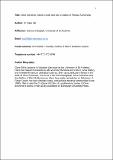Olive Schreiner, Marie Corelli and the anxieties of female authorship
Abstract
This article explores the competing models of gendered authorship emerging from Marie Corelli’s multiple print encounters with Olive Schreiner. Where Schreiner is cast by Corelli as the modish darling of a snobbish literary intelligentsia, who is beloved by critics and ignored by readers, Corelli herself emerges from her writings about Schreiner as the democratic author par excellence, a writer for the people rather than the press. In spite of the clear common ground that bridged their experience as celebrity authors, Corelli, in her writings about Schreiner, sought only to elucidate the ideological and artistic gulf that she identified as existing between them. As this essay will show, Corelli’s public resistance to Schreiner was a strike not only against an unfair male literary system of which she perceived Schreiner to be an arbitrary beneficiary, but also a rejection of the rhetoric of literary value that emerged in Britain during the fin de siècle. What Corelli failed to understand was that to be a woman writer at this time, however successful, was to occupy an ambiguous position within dominant, masculinist discourses of artistic distinction. A fuller exploration of Schreiner and Corelli’s positions within and experiences of the late-Victorian literary marketplace not only reveals the frailty of Correlli’s oppositional construction in real terms, but also signals the extent to which it was their shared status as women writers that was the key determinant shaping their respective experiences of professional authorship.
Citation
Gill , C 2020 , ' Olive Schreiner, Marie Corelli and the anxieties of female authorship ' , Journal of Victorian Culture , vol. Advance Articles , vcaa026 . https://doi.org/10.1093/jvcult/vcaa026
Publication
Journal of Victorian Culture
Status
Peer reviewed
ISSN
1355-5502Type
Journal article
Collections
Items in the St Andrews Research Repository are protected by copyright, with all rights reserved, unless otherwise indicated.

